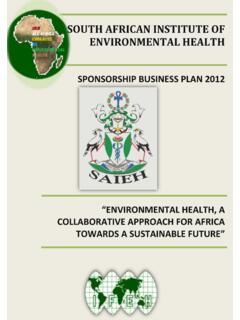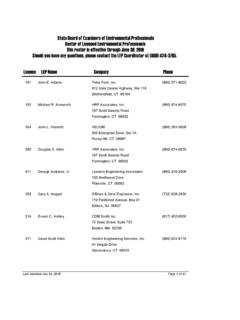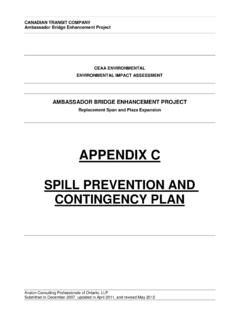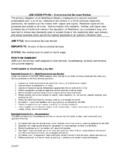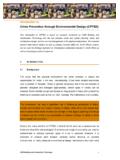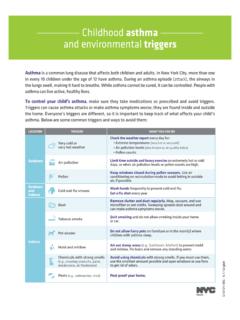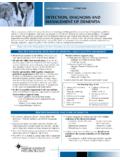Transcription of The Emerging Environmental Health Risks and Challenges …
1 The Emerging Environmental Health Risks and Challenges for Tomorrow: Prospects for Malawi Save Kumwenda1, 2, Young Samanyika1, 3, Elizabeth Chingaipe1, 4, Kondwani Mamba1, 5, Kingsley Lungu1,2, Chikondi Mwendera1, 2 and Khumbo Kalulu1, 2 1. Malawi Environmental Health Association 2. University of Malawi, The Polytechnic, Department of Environmental Health 3. Ministry of Health , Directorate of Preventive Health Services 4. Ministry of Health , Zomba District Health Office 5. Ministry of Health , Mangochi District Health Office Summary This paper gives an overview of the current and Emerging Environmental Health Risks and the projected Challenges for the future. The aim is to create awareness and incite debate among Environmental Health Professionals on solutions for the Risks and Challenges as they celebrate the World Environmental Health Day to be held on 26th September, 2013.
2 The Environmental Health Risks have been classified according to the five pillars of Environmental Health with climate change Risks and Challenges cutting across all the pillars. These include Emerging Risks and future Challenges related to food consumption, pollution of water resources, air and soil, use of electronic products and electronic waste, poor sanitation, poor housing and those arising from peoples occupation. If not controlled, these Risks and Challenges may result into increased prevalence of accidents, injuries, communicable and non-communicable diseases. We propose partnerships, stronger political will, innovations and research as key factors in solving such problems. Keywords: Environmental Health , Emerging Risks , climate change, water and sanitation, occupational Health , Environmental Pollution, food safety and Malawi Introduction According to the World Health Organization (WHO), Environmental Health addresses all Environmental (physical, chemical and biological) factors external to a person, and all the related factors impacting behaviours.
3 It encompasses the assessment and control of those Environmental factors that can potentially affect Health and is targeted towards preventing diseases and creating Health -supportive environments [1]. While most countries, especially those in the developing world like Malawi, are still struggling to address the existing Environmental Health problems, new Challenges and Risks are Emerging which require complex solutions. Advances in technology, population growth, changes in standard of living, increase in industrialization and climate change are some of the factors that lead to emergence of Challenges in Environmental Health . Emerging Risks and Challenges are those that are coming into existence because of changes in the environment. We present these factors according to the five pillars of Environmental pillars include: disease control, water, sanitation and hygiene (WASH), built environment, occupational Health and food safety and hygiene (FSH).
4 While these will be discussed, attention will also be given to how issues surrounding these pillars are being affected by climate change. Disease Control Under disease control, we discuss the current, Emerging and future Risks and Challenges relating to communicable and non-communicable diseases, epidemiology and Health promotion. Currently, Malawi faces a double burden of both communicable and non-communicable diseases[2] in the sense that while prevalence of communicable diseases is still high malaria related fever at 35% and diarrhea at in the under-fivechildren and prevalence of HIV among those aged 15 to 49 years [3], the Risks relating to non-communicable diseases are also high. A recent study showed that at least one in four men smoke tobacco, one in five people drink alcohol excessively and at least one in four women is overweight[4].
5 It also showed that a third ( ) of the adult population aged 25 64 years had raised blood pressure or were on antihypertensive medication, had raised fasting blood glucose or were on medication and had raised cholesterol [4]. The prevalence of diabetes was estimated at , while injuries, other than road traffic accidents, were at The prevalence of cardiovascular diseases was and that of asthma was The prevalence of road traffic accidents was estimated at [5]. It can be observed from evidence above that Malawi is facing a double epidemic of communicable and non-communicable diseases. The Risks associated with communicable diseases include inadequate safe water, sanitation and hygiene especially in rural and peri-urban areas (including institutions like schools and other public places), poor adoption of safe Health behaviours ( sleeping under treated mosquito nets, treating unsafe water, participating in immunizations and mass drug administration exercises), poor housing conditions, poverty and poor access to basic Health information and facilities.
6 The high burden of non-communicable diseases is partly due to increased drug and alcohol addiction, smoking, bad eating habits, poor food choices, pollution and Environmental these Risks are already in existence, we observe that more are Emerging including deforestation which will lead to reduction of quantities and pollution of water in water bodies, overcrowding, extreme temperatures due to climate change, pollutants from industries, use of genetic products and radiation from electronic products. Therefore, there is need for preparedness on how to tackle such Risks . In general, control of diseases through Health promotion will be challenged by technology where information leading to poor Health and that which promotes Health is available on the internet. Technology will reduce the need for people to work as a group and the need to gather as a result there will be need to empower people on how to choose the right information.
7 Those doing epidemiological studies will also be challenged by complex risk factors. It will be difficult to know the risk factors as they will become complex due to vast use of chemicals and modified products. There will be need for complex epidemiological methods to determine risk factors for ill Health in the society. Water, Sanitation and Hygiene Water supply, sanitation and hygiene mostly affect children and women living in rural and peri-urban areas of the country. People travel long distances to access water and in most cases the water sources are contaminated with chemical, physical and biological contaminants. These contaminants arise from unplanned settlements and associated poor sanitary conditions, as well as improper disposal of waste. The other sources are human settlements established in river catchment areas mainly because many households either do not have latrines or general waste disposal facilities.
8 There is also discharge of inadequately treated sewage from some institutions into rivers and streams. Lack of authority to control sanitary installations and of maintenance of sewer reticulation networks have led to overflow of septic tanks and sewers. On this pillar we discuss Emerging Environmental Health Risks and Challenges relating to access to safe water, rural and peri-urban sanitation, urban sanitation, Environmental pollution and hygiene. Access to safe water It is estimated that access to improved water sources is at around 78% of the population for the rural and 92% of the population for the urban areas [3]. Though the coverage seem to be very high, it is important to note that most of the Malawians live in rural areas where water is collected from communal water points and then transported to homes through various means and vessels.
9 Water is not normally used directly upon reaching the households. Water is stored for a period ranging from few hours to several days. This is also the case with households that do not have regular water supply though having in-house pipe connections. If not handled properly, water will get re-contaminated during collection, transportation and storage. Stored water can become unsafe when it is touched by people with dirty hands, when it is poured into a dirty container, when dirt or dust gets in the water, and when dirty cups are put into it. This fact necessitates inclusion of point of use treatment in order to holistically deal with water borne diseases. Another important area to note on water supply is the management of the water point. Waste water from water points needs to be taken care of in order to avoid breeding of mosquitoes as part of Malaria control and avoid contamination of groundwater through seepage.
10 Rural and Peri-Urban Sanitation and Environmental Pollution It is well known that only of the population in Malawi have access to improved faecal disposal facilities [3]. Most of the households (60%) use basic sanitation facilities while 8% of the households do not have any form of faecal disposal facilities meaning they defecate in the open. Open defecation exposes the rest of the population to excreta related diseases like diarrheal and helminthic diseases. Most public places including schools and markets do not have adequate faecal disposal facilities putting all children, patrons and surrounding communities at risk of related illnesses. Some of the complications in making progress on rural and peri-urban sanitation are depletion of natural resources that is making suitable construction materials to be scarce and unstable soil conditions in other parts of the country causing frequent facility collapses.

